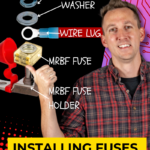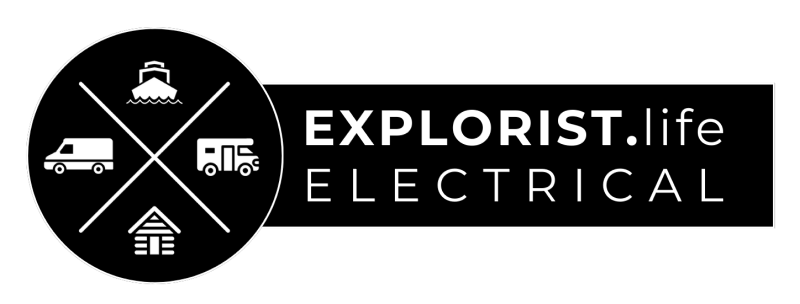
Installing a fuse in a fuse holder may seem straightforward. But after seeing countless mistakes, it’s clear that this simple task deserves its own dedicated tutorial. In this lesson of the Breakers, Fuses, and Overcurrent Protection playlist, we’ll break down how to properly install fuses, troubleshoot common errors, and ensure your electrical system stays safe and efficient.
Welcome to the EXPLORIST.life Mobile, Marine, and Off-Grid Electrical Academy! Let’s dive in.

INSTALLING FUSES AND BREAKERS – VIDEO
Coming Soon!
The Most Common Fuse Installation Mistake
The biggest issue we encounter—whether through in-person system checks at events or email support—is this: improper stacking of components on a fuse holder.
Here’s what often happens:
- Someone installs a fuse onto the fuse holder.
- They add a washer between the fuse and the wire lug.
- They tighten it all down with the lock washer and nut, thinking it’s good to go.
The problem? That washer disrupts the flow of power by introducing resistance. This resistance creates heat, leading to melted wires or fuse holders—all without the fuse ever blowing.
The Proper Way to Install Fuses
The fix is simple: get that washer out of the power flow.
Here’s the correct order for installing components:
- Place the fuse directly onto the conductive surface of the fuse holder.
- Add the wire lug on top of the fuse.
- Position the washer (if required) on top of the wire lug, followed by the lock washer and nut.
- Tighten everything with a wrench or socket to the manufacturer’s recommended torque.
This ensures power flows cleanly from the fuse holder to the fuse, through the wire lug, and into the wire—without any resistance-inducing washers getting in the way.
Different Fuses and How to Install Them
Let’s take a closer look at the most common fuses and their installation processes.
MRBF Fuses
MRBF (Marine Rated Battery Fuse) holders attach directly to battery terminals. To install:

- Place the fuse onto the holder.
- Add the wire lug, washer, lock washer, and nut (in that order).
- Tighten to spec with a wrench or socket.
ANL Fuses
ANL fuse holders handle high amperage.
- Remove all nuts and washers from the holder.
- Place the fuse on the copper bar.
- Add washers and nuts on top of the fuse.
- Tighten with a wrench.
MEGA Fuses

MEGA fuses are often used in fused busbars like the Lynx Distributor.
- Remove the top nuts and washers from the fuse studs, leaving the bottom nut in place.
- Set the fuse on the studs.
- Add the wire lug, washer, lock washer, and nut.
- Tighten securely with a wrench or socket.
MIDI Fuses
These smaller fuses work similarly to mega fuses but are often part of distribution systems like the Blue Sea SafetyHub.
- Remove screws and washers from the terminal.
- Place the fuse in its slot.
- Reinstall screws, ensuring no washer interferes with the power flow.
Blade Fuses
Blade fuses are common in automotive systems and simpler to install:
- Insert the blades into the slots of the holder.
- Push until secure.
PV Fuses
PV (photovoltaic) fuses for solar arrays are pre-assembled in connectors. Simply plug them into your PV combiner.
Breakers: A Quick Overview
Breakers, unlike fuses, are generally more foolproof. DC and AC breakers don’t usually involve washers, so there’s less risk of disrupting the power flow.
Key Takeaways
- Keep washers out of the power flow: Never place a washer between a fuse and a wire lug.
- Tighten connections properly: Use a wrench or socket to ensure a snug fit without over-tightening.
- Double-check the stack: Always verify the order of components to avoid resistance and heat buildup.
By following these steps, you’ll prevent overheating, ensure system reliability, and stay safe.
In our next lesson, we’ll cover how to choose the correct fuse size for your system. Stay tuned, and let’s keep building safe, efficient off-grid electrical setups together!
